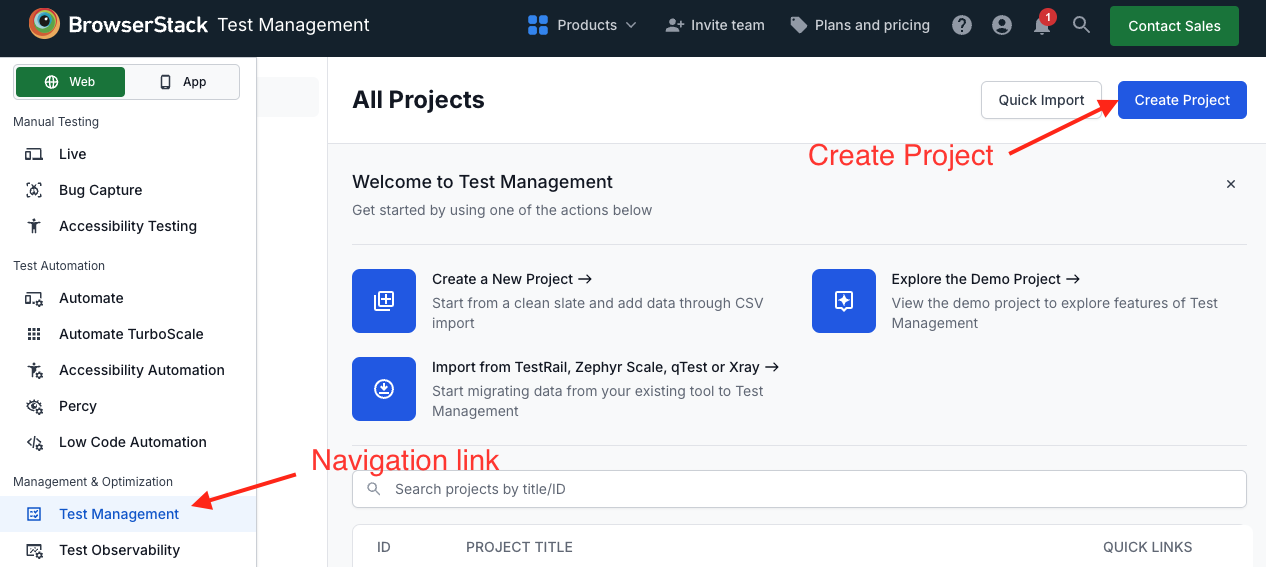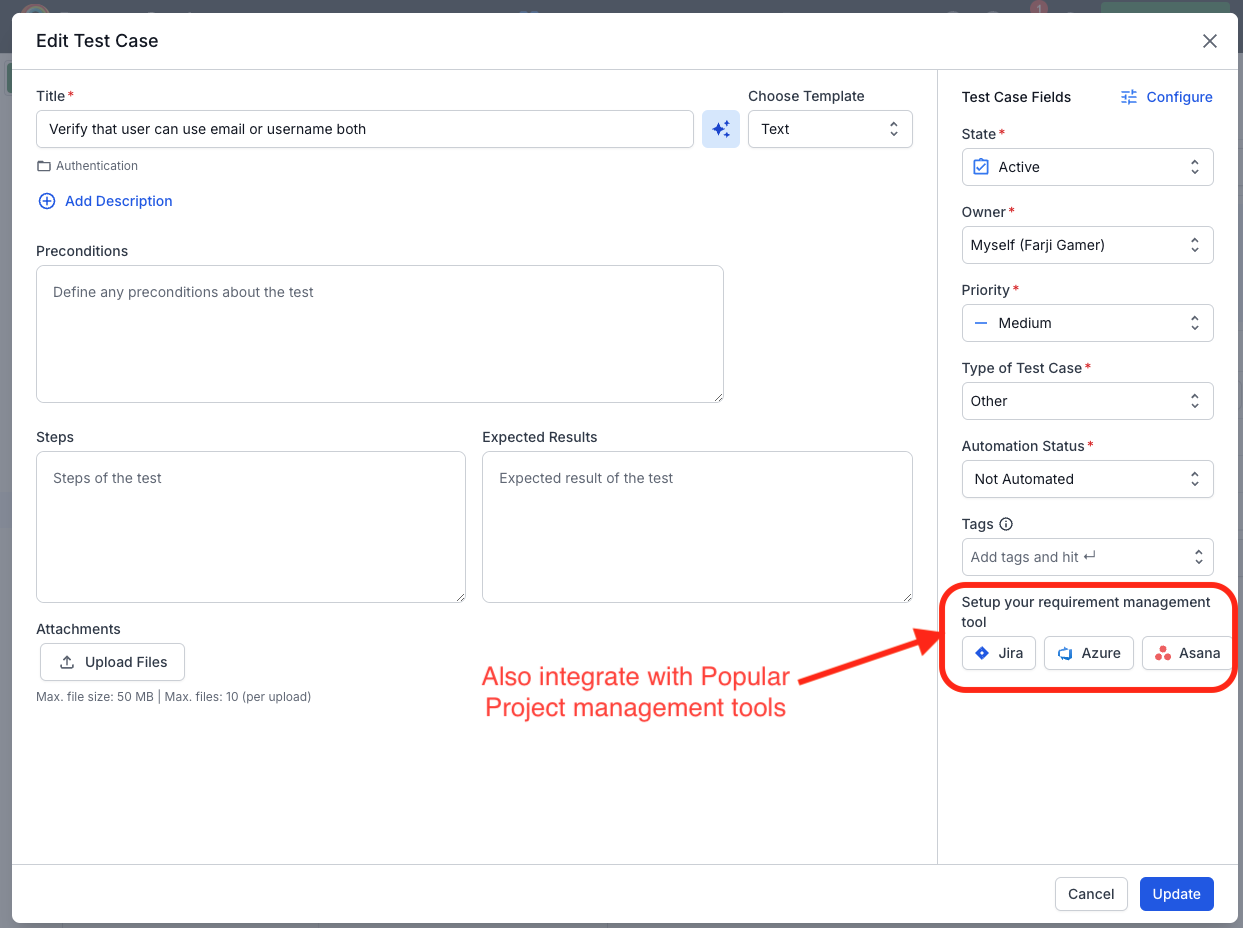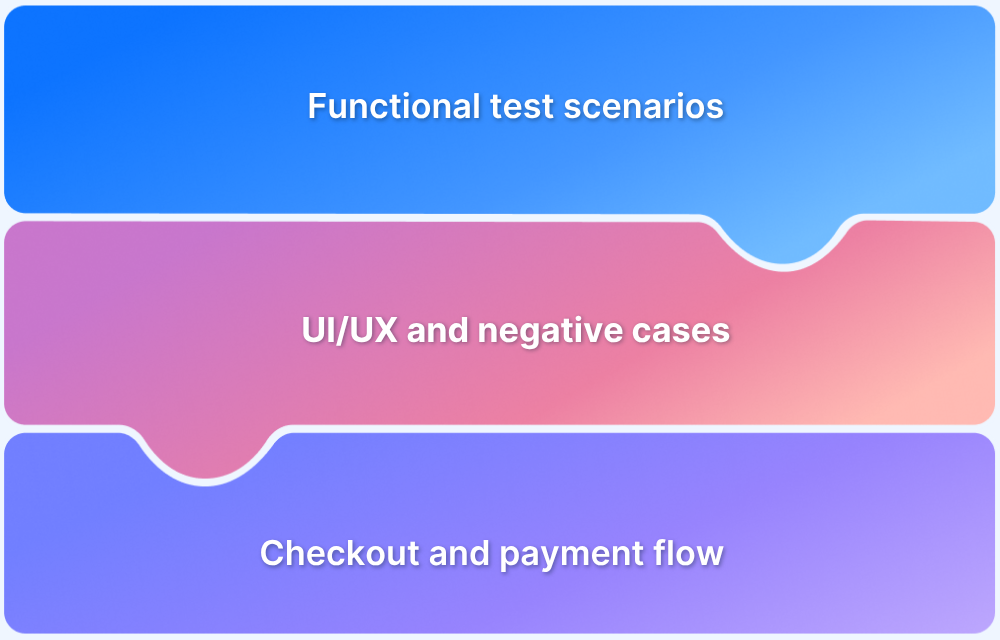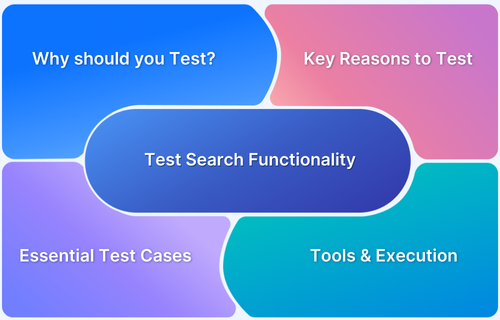E-commerce websites like Flipkart serve millions of users daily, making them among the most complex platforms to test. Writing effective test cases for large-scale websites is essential to ensure smooth functionality, usability, performance, and security.
Overview
Examples of Test Cases for Flipkart Website
- Login Page: Validate secure authentication, error handling, and password recovery.
- Home Page: Ensure fast load, responsive design, banners, search, and navigation work smoothly.
- Registration Page: Verify account creation, input validation, OTP, and duplicate checks.
- Address Book: Test add, edit, delete, sync, and validation of saved addresses.
- Search Page: Check accurate results, filters, suggestions, and performance.
- Wishlist Page: Validate add/remove, sync, share, and product details accuracy.
- Product Description Page: Verify product details, pricing, reviews, gallery, and add-to-cart.
- Add to Cart: Test adding/removing items, quantity, pricing, and session persistence.
- Order History Page: Ensure accurate order details, status updates, and filtering.
- Buy Flow: Validate end-to-end purchase journey, discounts, delivery, and confirmation.
- Payment Page: Test payment gateway, methods, failures, security, and transactions.
- Seller Product Creation: Verify product upload, categorization, and status handling.
- Post-Purchase Flow: Validate order confirmation, tracking, refunds, and cancellations.
- Payment Gateway: Ensure secure processing, discounts, interruptions, and accuracy.
- Shopping Cart: Test cart contents, variants, totals, limits, and responsiveness.
- Post Order Page: Verify delivery details, refunds, repeat order, and support info.
Comprehensive test cases help uncover potential issues early, maintain a high-quality user experience, and bolster customer trust.
Challenges of Testing Large Platforms Like Flipkart
Testing a large-scale e-commerce website like Flipkart comes with its own set of challenges:
- Vast Number of Features: E-commerce platforms have countless features, including search, checkout, payment, user reviews, etc., making it challenging to cover all possible scenarios.
- High Traffic: The site must perform under significant user loads, especially during peak times like sales and marketing campaigns.
- Multiple Integrations: Integration with third-party services like payment gateways and logistics partners adds complexity.
- Data Variability: The vast inventory and user-generated content create a variety of data scenarios that must be tested.
- Cross-browser and Cross-device Compatibility: Ensuring consistent behavior across various browsers and devices is crucial.
Different Testing Scenarios on Flipkart Website
When testing an e-commerce platform like Flipkart, various test scenarios need to be considered:
1. User Authentication:
- Ensure the sign-up, log-in, and log-out functionalities work as intended. Test scenarios should include using valid and invalid credentials, password recovery processes, multi-factor authentication (if applicable), and social media login integrations.
- Edge Cases: Test with incorrect formats, SQL injection attempts, and expired passwords.
2. Product Search and Filters:
- Validate that the search bar correctly retrieves relevant results based on product names, descriptions, and keywords. Test various filters, including price range, brand, color, and availability.
- Scenarios: Test with specific, broad, and misspelled search terms to ensure the search algorithm is robust.
3. Product Details:
- Verify that the product details page displays accurate and complete information, including product descriptions, images, specifications, and user reviews.
- Additional Checks: Ensure that image zoom, video playback, wishlist, discount, related products, location/zip check, and review sorting/filtering work as expected.
4. Shopping Cart:
- Ensure items can be added, removed, and updated in the shopping cart. Check for accurate item quantities, price calculations, and discount applications.
- Critical Tests: Validate behavior when items go out of stock after being added to the cart and when the cart is accessed across different devices (session persistence).
5. Checkout Process:
- Confirm that the user can seamlessly transition from the cart to the checkout process. This includes verifying address selection, order summary, payment options, and promo code application.
- Edge Cases: Test failed payments, double-click prevention on the checkout button, and session timeouts.
6. Payment Gateway Integration:
- Test the integration with various payment options such as credit/debit cards, UPI, wallets, and net banking. Ensure payment data is securely transmitted.
- Scenarios: Simulate payment failures, transaction timeouts, and interruptions.
7. Order Management:
- Verify order placement, cancellation, and tracking features. Ensure users receive order confirmation notifications via email and SMS.
- Special Cases: Test order modifications (e.g., address change before shipment) and return requests.
8. User Profile Management:
- Test editing personal details, changing passwords, and managing saved addresses. Ensure changes reflect promptly and that user sessions remain secure.
9. Performance Under Load:
- Conduct load testing to simulate high traffic, especially during peak shopping events. Monitor server response times, page load speeds, and overall system stability.
- Stress Testing: Push the site beyond its expected capacity to see how it behaves under extreme conditions.
10. Security Checks:
- Ensure user data is protected, both in storage and during transmission. Validate that sensitive operations, like payment and account settings, are protected against vulnerabilities.
- Tests: Include penetration testing, checks for XSS, CSRF, and SQL injection, and ensuring compliance with data protection standards.
Types of Test Cases for the Flipkart Website
Testing an e-commerce site involves different types of test cases:
- Functional Test Cases: Verify that the site’s core features are working as expected.
- Usability Test Cases: Ensure the site is user-friendly and intuitive.
- Performance Test Cases: Check that the website performs efficiently under various conditions.
- Security Test Cases: Validate that user data and transactions are secure.
Learn More: Automated Usability Testing
How to Write Functional Test Cases for Flipkart
Writing functional test cases requires a methodical approach to ensure comprehensive coverage.
Here’s how to go about it:
Steps to Write Functional Test Cases
Below are the steps to write functional test cases:
- Understand the Requirements: Start by gathering and understanding the functional requirements of the feature you are testing. This involves reviewing product specifications, user stories, and acceptance criteria.
- Break Down the Feature: Divide the feature into smaller, testable components. For example, if testing the checkout process, break it down into steps such as cart review, address selection, payment method, and order confirmation.
- Define Test Objectives: For each component, define clear objectives. For instance, ensure that the checkout button redirects users to the payment page.
- Create Positive and Negative Scenarios: Design test cases to cover positive and negative inputs. For example, test that valid card details process payments successfully, while invalid details show appropriate error messages.
- Document Test Steps: Write detailed test steps specifying the actions needed to execute the test, such as navigation, input fields, and button clicks.
- Define Expected Results: Clearly state the expected outcome for each test step. This helps validate whether the feature functions correctly.
- Review and Optimize: Peer review the test cases to identify missing scenarios redundant steps. Optimize the test cases for clarity and comprehensiveness.
Example Features to Cover
- User Authentication: Login and registration, password resets.
- Product Search and Filters: Search results accuracy, filter application.
- Shopping Cart Operations: Adding/removing items, calculating totals.
Read More: Fundamentals of Writing Good Test Cases
How to Write Usability Test Cases for Flipkart
Usability test cases focus on the user experience and ensure the website is intuitive and user-friendly.
Steps to Write Usability Test Cases
Below are the steps to write usability test cases:
- Identify Key User Flows: Determine which user flows are most critical to the user experience, such as product searches, navigation, and checkout processes.
- Evaluate Visual Consistency: Ensure page elements, such as buttons and menus, follow a consistent design language.
- Write Test Scenarios: Develop scenarios that assess how easily users can navigate the site. For example, check if the product categories are clearly labeled and accessible.
- Test Accessibility: Write test cases to ensure compliance with accessibility standards. Verify that screen readers can read page content and that navigation is keyboard-friendly.
- Simulate Real User Actions: Create test cases that simulate typical user behavior, like adding items to the cart or navigating between pages.
- Validate Mobile Responsiveness: Ensure the test cases include checks for different screen sizes and orientations.
Learn More: Usability Testing Tools
Example Aspects to Cover
- Navigation and Layout: Check for ease of use in finding key sections.
- Form Field Clarity: Ensure forms have clear labels and error messages.
How to Write Performance Test Cases for Flipkart Website
Performance test cases validate that the site can handle various loads and maintain acceptable response times.
Steps to Write Performance Test Cases
Below are the steps to write performance test cases:
- Define Performance Metrics: Establish key metrics such as response time, load time, and throughput.
- Identify Critical Scenarios: Focus on scenarios where performance is crucial, like searching for products or completing the checkout process.
- Simulate User Load: Write test cases to simulate various levels of traffic, including peak loads during sales events.
- Monitor Resource Utilization: Ensure that the test cases track server CPU, memory usage, and database response times.
- Set Baseline Performance Standards: Use baseline measurements to determine acceptable performance.
- Plan for Stress Testing: Include test cases that push the system beyond the expected load to see how it reacts under extreme conditions.
Key Areas to Test
- Page Load Times: Ensure that pages load within 3 seconds.
- Server Response Time: Validate that server responses are efficient even during high traffic.
How to Write Security Test Cases for Flipkart
Security test cases ensure the safety and integrity of user data and transactions.
Steps to Write Security Test Cases
Below are the steps to write security test cases:
- Identify Security Requirements: Understand the application’s specific security requirements, such as data encryption and secure login protocols.
- Assess Vulnerabilities: Review vulnerabilities like XSS, CSRF, SQL injection, and session hijacking.
- Create Test Scenarios: Develop test cases to verify secure handling of user data. For example, check that sensitive information is encrypted and not stored in plain text.
- Test Authentication Mechanisms: Write test cases for multi-factor authentication, password strength validation, and session expiration.
- Verify Secure Data Transfer: Ensure all data transferred between the client and server is encrypted using protocols like HTTPS.
- Simulate Attacks: Test the application’s response to simulated attacks to check for robust security measures.
Example Scenarios
- User Data Protection: Verify that user passwords are hashed.
- Payment Security: Test that payment data is handled through secure, PCI-compliant channels.
How to Perform Manual Testing for E-commerce Websites
Below are the steps to perform manual testing for E-commerce websites:
- Create Comprehensive Test Scenarios: Cover all major features and workflows., you can follow the checklist in the functional testing section.
- Simulate Real User Behavior: Test how a typical user would navigate and interact with the site.
- Cross-Browser Testing: Verify functionality across different browsers and devices.
- Regression Testing: Ensure that new code changes do not break existing functionality.
- User Feedback: Utilize feedback to guide test case creation and refinement.
- Do exploration of the application: Explore the application like a regular user, what challenges a user can encounter, eand xplore functionality to gain more understanding of the application
This checklist will help write comprehensive functional test cases for Flipkart website.
Automating Test Cases for Flipkart
Automating test cases can significantly improve test coverage, save time, and ensure consistency. BrowserStack Automate is one of the most effective tools for automation in this context.
BrowserStack Automate offers a powerful platform for executing automated tests on real browsers and devices, making it ideal for testing complex e-commerce sites like Flipkart.
Key features include:
- Accurate device testing for authentic user experiences.
- Cross-browser compatibility ensures consistent performance.
- Parallel testing accelerates test execution.
- Integrates seamlessly with CI/CD tools like Jenkins and GitHub Actions.
- Detailed reports with logs, screenshots, and video recordings aid debugging and analysis.
Write and Manage Test Cases Using BrowserStack Test Management
BrowserStack Test Management is an AI-powered, unified platform that accelerates test creation, execution, and automation, delivering up to 90% faster test authoring and 50% better coverage.
With real-time visibility, seamless integrations, and advanced AI agents, it streamlines workflows for both manual and automated testing.
Built for teams of any size, it ensures secure collaboration while enabling efficient, high-quality releases.
Key Features of BrowserStack Test Management:
- AI-Powered Test Case Creation: Automatically generate test cases from PRDs, user stories, or text prompts. Get AI-driven suggestions to enhance or refine existing cases, cutting down manual effort.
- Test Deduplication Agent: Identify duplicate or semantically similar test cases with intelligent merge/removal recommendations, keeping your test suite clean and efficient.
- Low-Code Automated Test Authoring: Convert manual test cases into low-code automated scripts, speeding up automation without requiring advanced coding skills.
- Intelligent Test Selection Agent: AI recommends the most relevant tests for execution, optimizing coverage and reducing redundant runs.
- Unified Test Management: Manage manual and automated test cases in one place, with end-to-end traceability through integrations with Jira, Azure DevOps, and more.
- Powerful Dashboard Analytics: Customizable dashboards track release status, visualize testing metrics, and monitor automation coverage with real-time insights.
- Shared Steps for Reusability: Mark repetitive steps as shared to simplify maintenance and increase efficiency across multiple test cases.
- Quick Import & Custom Field Mapping: Import test cases from CSVs or other tools, with automatic field mapping and custom field creation on the fly.
- AI-Powered Jira App with Two-Way Binding: Keep Jira and BrowserStack Test Management in sync, with AI assistance for managing test cases from either platform.
- Streamlined Test Runs: Plan and execute both manual and automated test runs, with dynamic test inclusion and support for uploading results from JUnit, BDD-JSON, and more.
- Support for Frameworks & CI/CD Tools: Integrate with Appium, Playwright, TestNG, Jenkins, Azure Pipelines, Bamboo, and other frameworks/tools for scalable automation.
The free version of BrowserStack Test Management offers unlimited test cases, robust integrations, and real-time reporting capabilities.
Try BrowserStack Test Management
Step-by-Step Guide to Using BrowserStack Test Management
Below are the steps to use BrowserStack test management:
Step 1: Creating a Project
- Log in to your BrowserStack account.
- Navigate to Test Management and click “Create New Project.”
- Enter project details and save to begin organizing test cases.
Step 2: Creating Test Cases in the Project:
- Open your project and click Add Test Case.
- Enter the title, steps, expected results, and tags.
- Use the Generate Test Cases with AI feature (in beta) for automated test creation.
- You Can also import existing test cases from any other test management platform like TestRail or a CSV file.
- Save to make the test cases available for execution.
Step 3: Shared Steps
- Go to Shared Steps and define common steps (e.g., login).
- Save shared steps for reuse in multiple test cases.
Step 4: Creating a Test Cycle:
- Navigate to Test Cycles and click Create Test Cycle.
- Add a name and description, and select test cases.
- Assign team members and set priorities.
- Save to start the test cycle.
Step 5: Test Run Insights on Dashboard:
- Monitor test cycle progress in real-time on the dashboard.
- View pass/fail rates, execution time, and statuses.
- Use logs and reports for analysis, collaboration, and data-driven decisions.
Conclusion
Writing detailed test cases for an e-commerce platform like Flipkart requires careful consideration of various testing aspects, from functionality to performance and security.
By employing custom test cases and leveraging tools like BrowserStack Automate, teams can ensure their website delivers a seamless user experience.
Useful Resources for Test Case
Understanding Test Case:
- What is a Test Suite & Test Case? (with Examples)
- What is Test Case Specification?
- Fundamentals of Writing Good Test Cases
- Understanding what is UI Test Cases (with Examples)
- Test Case Vs Test Script
- Test Plan vs Test Case: Core Differences
- Use Case vs Test Case: Core Differences
- Test Case Review Process
- Captcha Test Case
- Test Case Templates with Example
Tutorials and Best Practices:
- How to Write Test Cases for Login Page
- How to optimize test cases for Continuous Integration
- How to speed up UI Test Cases
- How to run parallel test cases in TestNG
- How to write JUnit test cases
- How to write Test Cases for Gmail
- How to write Test Cases for Mobile Applications
- How Automation of Regression Test Cases can be Cost Effective
- How to Create Test Cases for Automated tests?
- How to create Selenium test cases
- How to write Test Cases in Software Testing? (with Format & Example)
- How to write Test Case in Cypress: (with testing example)
- How to run failed test cases using TestNG in Selenium Webdriver?
- How to take Screenshot of Failed Test Cases in Cucumber
- How to run JUnit 4 Test Cases in JUnit 5
- How to create and manage test cases in Jira and BrowserStack Test Management
- How to make your Selenium test cases run faster
- How to Write Test Cases for Amazon Shopping?
- Test Cases for Search Functionality
- Test Cases for ECommerce Website
- Test Cases for Facebook Login Page
- Test Case Reduction and Techniques to Follow
Frequently Asked Questions
How to Write a Test Scenario for an E-Commerce Website?
Focus on core user journeys like login, product search, add-to-cart, checkout, and payment. Write high-level scenarios that validate these flows from the customer’s perspective, ensuring end-to-end functionality works as expected.














